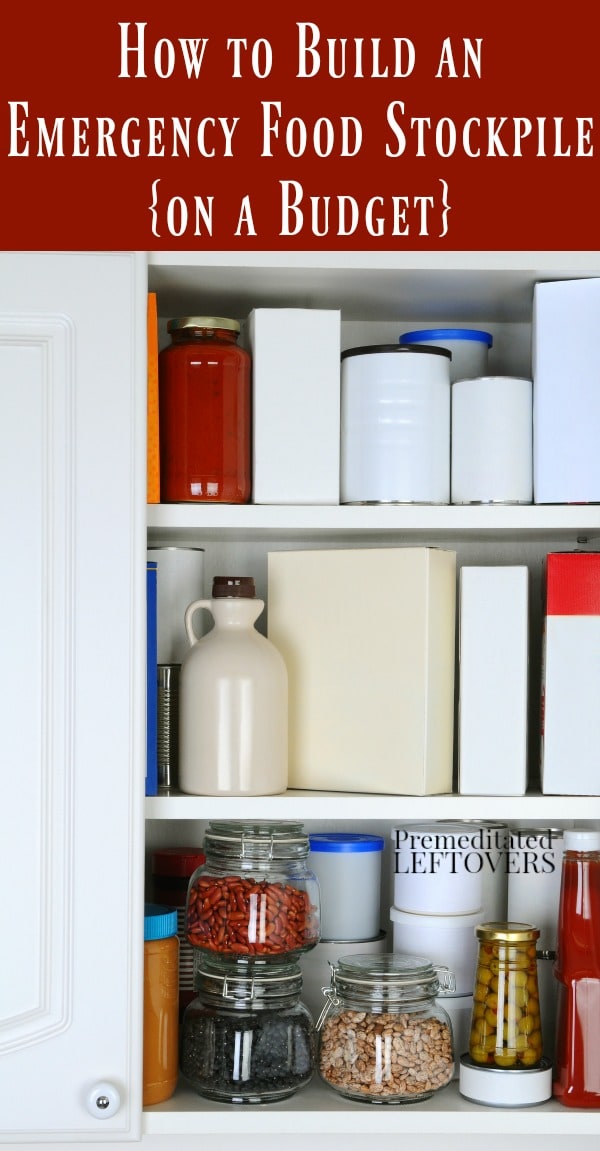When you’re working on helping your family be prepared, one of the first things you should do is build a food stockpile. It doesn’t matter whether you’re preparing for storms, job loss, or worse. Food is the one need that they all have in common. Running out and just buying all of the food for your emergency stockpile is a surefire way to break your piggy bank right in half. Instead, work slowly and use the tips below to learn How to Build an Emergency Food Stockpile on a Budget.
How to Build an Emergency Food Stockpile on a Budget
Start small – If you go out and buy six cartloads full of groceries, you’re going to accomplish only one thing: draining your bank account. Instead, build your stockpile slowly and steadily. When you go to the store, buy extra of what you’re already buying. If you buy 5 cans of tuna normally, buy 10 cans for 2 or 3 trips or until you have enough built up that you’re comfortable.
Use coupons – Stockpile things like cereal, canned soups, household goods and health products can be significantly cheaper with a coupon. While you shouldn’t take it to the extreme, saving a few cents and dollars here and there never hurt anyone. You can find coupons here.
Buy on sale – This goes hand in hand with starting small. If you’re buying something because it’s on sale, then buy more than you currently need within reason. It is better to buy a few more when you’re paying less than to buy it when it is regular price. You might only save a dollar or two but over time that dollar will add up. Want to save even more? Combine your sales with your coupons.
Buy Only What You Need – Yes, you’re trying to build a stockpile. If you fill it with foods that your family won’t eat you won’t have much more than shelves of unopened cans and boxes. Instead, buy what you eat and eat what you stock. This goes for beverages that you might be stocking up on too.
Minimize waste – When you buy a product for your stockpile, especially food or beverages, make sure that you write either the expiration date or the date of purchase on it using a sharpie. When things expire without being used, you’re doing nothing but throwing money down the drain. Keeping waste to a minimum is the best way to make sure that you’re not wasting your money too. Another way to keep yourself from wasting foods is to make sure your stockpile is rotated. When you’re putting it away, put your new purchases in the back so that you use the older stock first.
Keep track of what you have on hand – Have you ever gone to the store and bought something only to bring it home and find out that you have 20? That can spell wasted money for a stockpile. Making sure that you keep track of what you have on hand with a spreadsheet or other organized method will help you do that without too much work. After all, if you have enough of something, there is no need to buy more. Here is a Printable Pantry Inventory List and a Printable Freezer Inventory List to help you keep track of what you already have on hand.
When you’re budgeting for your stockpile, don’t add too much to your grocery budget each month. Instead, work to get your actual grocery costs down and use what is left to stockpile. If that absolutely isn’t possible, start with a small amount like $20.00 extra. You would be surprised at how quickly you can build a usable stockpile with an extra $20.00.
More Ways to Save On Groceries
10 Secret Tips to Save Money on Groceries
7 Insanely Easy Ways To Cut Your Grocery Bill


Lindsey says
During my stockpile period, I used to save about $100 and use that money to heavily stockpile. It’s paid off so much now since we aren’t buying things like shampoo or razors.